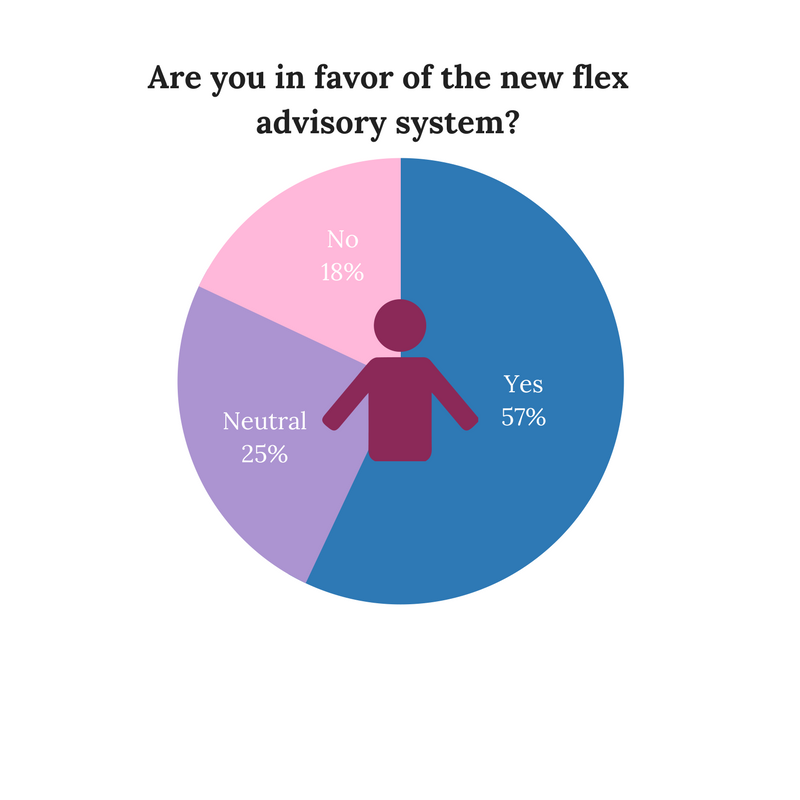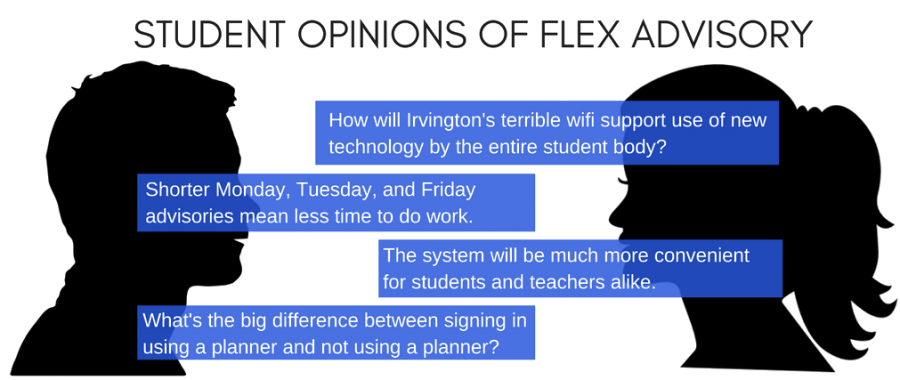Irvington considers implementation of new flex advisory
The new flex advisory system would not require students to use planners in order to move from one advisory to another for tutorial, and instead would use a website.
April 30, 2018
Since the beginning of the 2017-18 school year, the Irvington Advisory Committee –comprised of select staff and ASG members– has considered implementing a new advisory system to allow for more effective use of advisory. The new flex advisory would take away six minutes from advisory on Monday, Tuesday, and Friday, and add nine minutes to the Wednesday and Thursday block day tutorials providing more time for making up assignments or tests and reducing travel time between classrooms.
“Instead of having to start off in your advisory class with tutorial passes,” Principal Melsby said. “you’d go directly to whatever room you desire to go to, and that’s how the technology makes it really nice. Through the website, you login, make an appointment with the teacher you want to, and show up with your ID card, which they scan and that pops up on the roster as you having signed in.”
Furthermore, Irvington ASG plans to make a phone app that connects to the flex advisory website, teachermore.org, to increase ease of tutorial movement.
“The app could be extra beneficial if you have it, making it easier if you schedule your appointment for as far in advance as you’d like,” Mr. Willer said. “The biggest drawback would be taking the data from the flex app and inputting it into our attendance system. It’s a matter of making the two systems working together.”
Irvington’s advisory committee cites various reasons for the implementation of the new flex advisory, such as inadequate time to make-up tests, inconvenient traveling back and forth between the student’s normal advisory to the class he or she desires to move to, and the ineffectiveness of the current advisory system.
“A lot of the issues came up with inconsistencies with advisories across campus,” ASG President Rohith Dara (12) said. “ At the beginning of the year, we started planning out how we were going to roll through this and the first thing we started doing was the survey that asked how students used advisory and whether or not it was effective. This is when we learned about the flex advisory system.”
While Irvington High School was the first school to implement advisory, the new flex advisory is based off of a similar system that American and Kennedy High School currently use. While at American, flex advisory is scheduled for Wednesday, Thursday, and Friday with no advisory or homeroom on Monday and Tuesday, Irvington’s proposal would only be on unique to Wednesday and Thursday block days with shorter advisories on the other school days.
“We thought modeling the advisory system too similarly to American’s would be too drastic a change because students would be mad if we took away advisory,” ASGB President Rohith Dara said. “Instead, we made a hybrid between the current system we have and the flex system at American.”
The flex advisory at American High School is used for multiple purposes from decreased tardiness to better learning environments.
“We went to a science classroom and in that room, they had the AP students of the subject tutoring the regular students and the AP students were told that if they do a certain number of hours of tutoring, they wouldn’t need to do the end of chapter reviews,” Mr. Willer said. “Instead of being loud, it was an active, engaged room of people discussing biology. Meanwhile the room next door was the exact opposite. It was a quiet study room for the same subject but for those who work better alone.”
Not only does the flex advisory induce better ways for students to learn, it also allows for teachers to make appointments with students struggling in the classroom to ensure that students are not wandering into different advisories instead of using advisory time to make-up work. If a student does not make an appointment, they are allowed to walk into any class and see if the teacher has space. However, there are various concerns regarding the technology of the new scanning system.
“Some teachers were concerned about the technology, and that they already have to manage school loop, Illuminate, and the district email,” Principal Melsby said, “but the website is very user-friendly.”
In addition, Mr. Willer said that members of ASG will be available to assist teachers who feel uncomfortable or are unfamiliar with the new technology.
Meanwhile, some students have raised concerns that the new flex advisory will interfere with their preferred use of advisory as free time or as a period to relax before they continue their day.
“I think [flex advisory] can have both, because some students want to do activities and some want to have free time,” President Dara said. “This just opens the door to create a platform where students can do what they actually want. Our opportunities right now are very limited. This allows more people to know about things on campus and give them an easier way to get to them.”
Although flex advisory has not been formally established, Irvington staff will vote on whether or not they will implement the flex advisory late in April along with other items included in the yearly vote to make changes for the school. If passed, flex advisory will begin in the 2018-19 school year.












